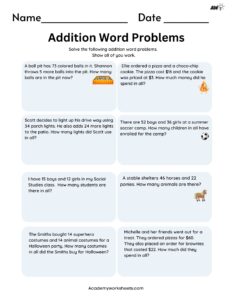2 digit Addition Word Problems
These math word problems involving the addition of one and two digit numbers with no carrying. Sums are less than 100.
Addition is one of the most fundamental operations in math, laying the groundwork for more advanced concepts. Working with single and double-digit numbers, up to 99, is a crucial step in a child’s mathematical development. These numbers are manageable to work with, yet they provide a sufficient challenge to stimulate a child’s cognitive growth.
Word problems in particular bring a real-world context to math, making it more relatable and engaging for children. They present scenarios that children might encounter in their daily life, such as buying items from a store, sharing toys with friends, or counting objects. For example, a word problem might state: “Sam has 12 apples. He buys 7 more. How many apples does Sam have now?”
These problems require children to perform addition operations with single and double-digit numbers, often combining both. For example, “Anna has 9 balloons and her friend gives her 20 more. How many balloons does she have now?”
Such problems introduce children to the concepts of carrying and borrowing. They also help children develop problem-solving skills as they must first understand the problem, then devise a plan to solve it, and finally carry out that plan.
Moreover, addition word problems reinforce the concept of number bonds—the idea that numbers can be split into different pairs of numbers. This is a fundamental concept in number sense, the understanding of how numbers work together, which is a foundational skill for all future math learning.
Overall, the practice of solving word problems with single and double-digit numbers up to 99 is not just about learning addition. It’s about developing problem-solving skills, promoting logical thinking, enhancing number sense, and making math a more engaging and meaningful subject for children.
2 digit Addition Word Problems 2





